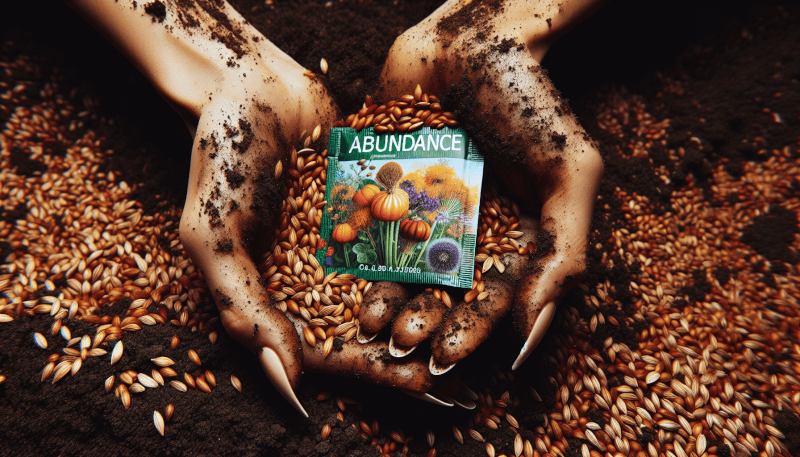👋 Click the mic button to talk to Alfred, the Todd's Seeds Gardening/Sprouting Expert – Feel free to ask him anything!
Ask Virtual Todd Anything - Click the Mic
Are you a green thumb looking to start your own garden but hesitant to spend money on seeds? Well, look no further! We have exciting news for you – Free Garden Seeds! Yes, you heard it right. You can now get your hands on a wide variety of garden seeds without spending a single penny. Whether you’re interested in growing fruits, vegetables, herbs, or flowers, we have a generous selection of seeds just waiting for eager gardeners like you. With Free Garden Seeds, you can kickstart your gardening journey and watch your plants bloom and flourish, all without breaking the bank. So, what are you waiting for? Let’s get digging and start growing your dream garden today!

Benefits of Free Garden Seeds
Saving Money
One of the most obvious benefits of using free garden seeds is the money you can save. When you start a garden, seeds can be a significant expense, especially if you’re looking for a wide variety of plants. By obtaining seeds for free, you can significantly reduce your gardening costs and allocate those savings towards other aspects of your garden, such as soil amendments or helpful tools.
Variety of Options
Using free garden seeds also opens up a world of possibilities when it comes to plant variety. Many seed-saving initiatives and communities offer a diverse range of seeds that you may not find in your local garden center. This allows you to experiment with different types of plants, explore unique heirloom varieties, and create a truly personalized garden. With free garden seeds, you have the freedom to grow a diverse array of fruits, vegetables, flowers, and herbs, adding excitement and curiosity to your gardening experience.
Encourages Gardening
The availability of free garden seeds encourages more people to take up gardening as a hobby. When seeds are readily accessible and affordable, it removes a potential barrier for beginners who may feel intimidated by the initial investment. By making seeds more accessible, it fosters a sense of curiosity and experimentation, motivating more individuals to try their hand at growing plants. Gardening can be a rewarding and therapeutic activity that brings joy, relaxation, and a connection to nature, making it a wonderful hobby for people of all ages and backgrounds.
Promotes Sustainable Practices
Using free garden seeds promotes sustainable practices in gardening. By saving and exchanging seeds, we reduce the demand for commercially produced seeds, which often require extensive resources and contribute to environmental pollution. Free garden seeds encourage the practice of seed-saving, allowing us to become more self-sufficient and less reliant on the industrial seed market. Furthermore, growing our own plants from seeds helps to protect biodiversity by preserving heirloom and native varieties in our gardens.
Sources of Free Garden Seeds
Seed Swaps
Seed swaps are a fantastic way to obtain free garden seeds while engaging with a community of fellow gardeners. These events bring together individuals who have saved their own seeds and are interested in sharing them with others. Seed swaps offer an excellent opportunity to acquire a wide range of seeds, from vegetables and fruits to flowers and herbs. Often held at local community centers, seed swaps allow you to meet like-minded gardeners, exchange gardening tips, and discover new plants to grow in your garden.
Seed Libraries
Seed libraries have been gaining popularity in recent years as a unique resource for free garden seeds. These libraries function similarly to traditional lending libraries but with a focus on plant seeds instead of books. Participants can “check out” seeds for the gardening season, grow the plants, and then return a portion of the harvested seeds at the end of the season. The returned seeds are then shared with other community members, creating a sustainable cycle of seed sharing. Seed libraries are typically found in public libraries, community centers, or botanical gardens.
Online Communities and Forums
The internet has revolutionized the way gardeners connect and share resources. There are numerous online communities and forums where gardeners can find and exchange free garden seeds. Websites and social media platforms dedicated to gardening provide a platform for individuals to connect, share their experiences, and offer seeds to fellow gardeners. These online communities often have dedicated seed-swap sections or groups where members can post seed offerings and requests for specific seeds.
Local Gardening Groups
Joining local gardening groups is an excellent way to find free garden seeds and connect with fellow gardeners in your area. Many communities have gardening clubs, urban farming initiatives, or neighborhood associations dedicated to fostering green spaces and encouraging gardening. These groups often organize seed exchanges or have members who are eager to share their excess seeds. By participating in local gardening groups, you not only expand your seed collection but also receive valuable knowledge and support from experienced gardeners in your community.
Seed Exchanges
Seed exchanges are events organized specifically for the purpose of exchanging seeds. These events may take place at community centers, botanical gardens, or even schools. Seed exchanges bring together individuals who have saved their own seeds and provide a platform for trading seeds with one another. They offer an opportunity to connect with other gardeners, discover interesting plant varieties, and expand your seed collection without spending any money.

Tips for Finding Free Garden Seeds
Research Local Resources
To find free garden seeds in your area, it’s essential to research local resources. Look for community gardens, gardening organizations, or seed-saving initiatives near you. Check their websites, social media pages, or contact them directly to inquire about opportunities to obtain free seeds. Additionally, keep an eye out for local gardening events or seed exchanges that might be taking place in your vicinity.
Participate in Seed Swaps
Attending seed swaps is a fantastic way to find a wide variety of free garden seeds. Research upcoming seed swap events in your area and mark them on your calendar. When attending, bring some of your own saved seeds to contribute to the swap and be prepared to engage with fellow gardeners. By actively participating in seed swaps, not only will you leave with new seeds for your garden, but you’ll also forge connections with other passionate gardeners and gain valuable insights and tips.
Join Seed Libraries
Start by finding out if there are any seed libraries in your community. Public libraries are a great place to begin your search, as they often have the necessary resources and infrastructure to host seed libraries. Take a trip to the library and inquire with the staff about the availability of free seeds. If a seed library exists, they will guide you on the process of checking out seeds and returning harvested seeds at the end of the season. Joining a seed library allows you access to a diverse range of seeds without any financial burden.
Connect with Online Gardening Communities
The internet provides a wealth of opportunities to connect with other gardeners and find free garden seeds. Joining online gardening communities or forums allows you to interact with a vast network of gardeners from around the world. These communities often have dedicated sections for seed swapping or sharing. Introduce yourself, participate actively, and offer any excess seeds you may have. By contributing and connecting with fellow gardeners online, you increase your chances of receiving free garden seeds in return.
Attend Local Gardening Events
Stay updated on local gardening events, such as workshops, seminars, or garden tours. These events are not only educational but also present opportunities to obtain free garden seeds. Often, organizers or fellow participants bring extra seeds to share with attendees. Make sure to introduce yourself to other attendees and strike up conversations about gardening. By attending local gardening events, you not only learn from experts but also build relationships within the gardening community, which can lead to future seed-sharing opportunities.
Preparing for Free Garden Seeds
Assess Your Garden Space
Before acquiring and planting free garden seeds, it’s essential to assess your garden space. Determine the available area and sunlight exposure, as different plants have varying requirements. Analyze the soil quality and consider any necessary amendments to provide optimal conditions for your seeds. By assessing your garden space beforehand, you can plan your planting strategy accordingly and ensure the successful growth of your seeds.
Gather Necessary Tools and Supplies
Having the right tools and supplies is crucial for successful seed planting. Gather basic gardening tools such as a trowel, fork, rake, and gloves. Depending on the scale of your garden, you may also need stakes, trellises, or cages for supporting certain plants. Additionally, ensure you have adequate soil, compost, or any other amendments necessary to enrich the soil. By gathering all the necessary tools and supplies in advance, you’ll be prepared to plant your free garden seeds efficiently.
Plan Your Garden Layout
Take some time to plan your garden layout before planting your free garden seeds. Consider factors such as plant spacing, companion planting, and crop rotation. Group plants with similar water and sunlight needs together to optimize resource allocation. Additionally, consider aesthetics and create a visually appealing arrangement in your garden. By planning your garden layout, you can maximize the use of available space, increase the chances of successful growth, and create an organized and beautiful garden.
Prepare Soil and Bedding
Properly preparing the soil and bedding is essential for the successful growth of your free garden seeds. Weed the area to remove any unwanted plants or grass. Loosen the soil with a fork or tiller to improve aeration and drainage. If needed, amend the soil with compost or nutrients to provide a fertile environment for your seeds. Level the soil surface and create raised beds or planting rows based on your garden layout. By preparing the soil and bedding thoroughly, you set the stage for healthy and robust seed growth.
Create a Seed Starting Schedule
To ensure a continuous harvest and maximize the productivity of your garden, create a seed starting schedule. Different plants have different growing requirements and timelines. Research each plant variety and determine the optimal time to start seeds indoors or directly sow them in the garden. Planning your seed starting schedule allows you to stagger plantings and have a continuous supply of produce throughout the growing season. By following a schedule, you can maximize the potential of your free garden seeds and enjoy a bountiful harvest.

Planting and Growing Free Garden Seeds
Read Seed Packets
Before planting your free garden seeds, it’s important to read the information provided on the seed packets. Seed packets typically include valuable details such as planting depth, spacing, water requirements, and days to maturity. Understanding these instructions is crucial for the successful germination and growth of your seeds. Take the time to familiarize yourself with the specific needs of each plant variety and follow the instructions accordingly.
Follow Planting Instructions
Once you’ve read the seed packets, follow the planting instructions provided. Different seeds may have varying requirements, such as pre-soaking, scarification, or stratification. Some seeds may need to be started indoors in trays, while others can be directly sown into the garden. By following the planting instructions carefully, you ensure that your free garden seeds have the best chance of germinating and thriving in their new environment.
Provide Adequate Water and Sunlight
Water and sunlight are essential for the growth and development of plants. Ensure that your free garden seeds receive adequate water and sunlight according to their specific needs. Monitor the moisture levels of the soil, especially during periods of dry weather, and water as necessary. Observe the sunlight patterns in your garden and position your plants accordingly, considering their light requirements. By providing the ideal conditions of water and sunlight, you support healthy and vigorous growth of your free garden seeds.
Implement Pest Control Measures
Protecting your free garden seeds from pests is crucial for their survival and productivity. Implement pest control measures, such as using organic pesticides or natural deterrents, to prevent infestations. Regularly inspect your plants for signs of damage or pests and take immediate action if necessary. By staying vigilant and implementing effective pest control measures, you can protect your free garden seeds from potential threats and ensure the health and vitality of your garden.
Monitor Plant Growth and Progress
Continuously monitor the growth and progress of your free garden seeds. Regularly observe the plants for any signs of nutrient deficiencies, disease, or pests. Adjust watering, fertilization, or pest control practices as needed. Observe the development of flowers, fruits, or vegetables and harvest them in a timely manner. By actively monitoring your plants, you can address any issues promptly and ensure that your free garden seeds reach their full potential.
Harvesting and Saving Free Garden Seeds
Identify Mature Plants
To begin the process of harvesting free garden seeds, it’s important to identify mature plants. Different plants have different indicators of maturity, such as changes in color, size, or texture. Research the specific characteristics of each plant variety and learn to recognize when they are ready to produce seeds. By accurately identifying mature plants, you can harvest the seeds at the optimal time for the best quality and viability.
Properly Harvest Seeds
Once the plants are mature, it’s time to harvest the free garden seeds. Depending on the type of plant, the seeds may be located within fruits, pods, or flower heads. Use appropriate harvesting techniques to collect the seeds without causing damage. For example, gently squeeze tomato fruits to extract the seeds or allow flower heads to dry, and then collect the seeds by shaking or rubbing. By properly harvesting the seeds, you ensure their integrity and readiness for storing or sharing.
Dry and Store Seeds
After harvesting, it’s crucial to dry the free garden seeds thoroughly before storing them. Spread the seeds out on a clean tray or paper towel and allow them to air dry in a well-ventilated area. Make sure the seeds are completely dry before moving them to storage containers. Proper drying prevents mold and ensures the longevity of the seeds. Once dry, transfer the seeds to airtight containers, such as glass jars or seed envelopes, and store them in a cool, dark, and dry place.
Label and Organize Seeds
To keep track of your free garden seeds, it’s important to label and organize them properly. Use permanent markers or labels to identify the plant variety, date of harvest, and any specific details about the seeds. Create a system for categorizing and sorting your seeds based on their type or planting season. By labeling and organizing your seeds, you can easily find and access them when you need to plant or share them in the future.
Share Excess Seeds
One of the joys of having free garden seeds is the ability to share them with others. If you have an excess amount of seeds, consider sharing them with friends, family, or local gardening organizations. Spread the joy of gardening by passing along your knowledge and seeds to others. By sharing your excess seeds, you contribute to a sense of community and inspire others to start their own gardens, creating a ripple effect of sustainable and enjoyable gardening practices.

Seed Saving Techniques
Open-Pollinated vs. Hybrid Seeds
Understanding the difference between open-pollinated and hybrid seeds is crucial when saving seeds. Open-pollinated seeds are pollinated naturally by wind, insects, or other natural means. These plants grow true to their parent plant, allowing you to save and sow their seeds for future generations. On the other hand, hybrid seeds are the result of controlled cross-pollination between two different plant varieties. The seeds produced from hybrid plants will not grow true to their parent plant, often resulting in inconsistent traits. Therefore, it’s important to save seeds only from open-pollinated plants if you want to preserve the characteristics of a particular variety.
Isolation and Cross-Pollination
To maintain the genetic integrity of open-pollinated plants, it’s necessary to prevent cross-pollination. Different plant varieties can cross-pollinate with each other, resulting in hybridized seeds. To isolate plants and minimize cross-pollination, keep different varieties of the same species a safe distance apart. This distance varies for different plants, so it’s crucial to research the specific isolation requirements for each crop. Alternatively, use physical barriers, such as netting or bags, to protect the flowers from unwanted pollinators. Taking precautions to prevent cross-pollination ensures that your saved seeds remain true to the parent plants’ characteristics.
Seed Cleaning Methods
Cleaning seeds before storage is an important step to remove any debris, chaff, or immature seeds. Different seed types require specific cleaning methods. For dry seeds, simple winnowing or sieving can help remove unwanted materials. Wet seeds, such as those in fruits or fleshy pods, require fermentation or washing to separate the seeds from the surrounding pulp. Research the recommended cleaning methods for each type of seed you save to ensure that they are properly cleaned and ready for storage.
Long-Term Seed Storage
Proper long-term seed storage is essential to preserve seed viability. Seeds must be stored in a cool, dark, and dry environment to maintain their quality. Ideally, the storage temperature should be around 32°F to 41°F (0°C to 5°C) with low humidity. Store seeds in airtight containers, such as glass jars or seed-specific envelopes, to protect them from moisture and pests. To further enhance longevity, consider adding silica gel packets or moisture-absorbing materials to the storage containers. Regularly check stored seeds for any signs of deterioration or mold and discard any compromised seeds.
Maintaining Seed Viability
The viability of saved seeds can decrease over time, so it’s important to regularly test their germination rate. Take a sample of seeds from each stored variety and conduct a germination test before planting them on a larger scale. Place the seeds on a moist paper towel or in germination trays and observe how many seeds successfully sprout. Based on the germination rate, you can determine the viability and adjust the planting density accordingly. Maintaining seed viability ensures that your saved seeds will yield healthy and productive plants in future seasons.
Seed Saving Challenges and Solutions
Cross-Pollination Risks
Cross-pollination can pose challenges when saving seeds, especially for plants that are open-pollinated and easily hybridize. To mitigate cross-pollination risks, practice isolation techniques such as distance planting or using physical barriers. Research the specific isolation requirements for each plant variety and plan your garden accordingly. Additionally, consider staggered planting or time-based pollination to limit cross-pollination between different varieties. Vigilance and careful planning are key to ensuring that your saved seeds remain true to the desired parent plants.
Maintaining Genetic Diversity
Maintaining genetic diversity is crucial for the long-term resilience and health of plant populations. When saving seeds, it’s important to preserve the genetic diversity of different plant varieties. Make an effort to save seeds from multiple individuals within a variety, as this helps retain a wide range of genetic traits. Moreover, actively seek out rare or heirloom varieties to grow in your garden and save their seeds. By consciously preserving and diversifying your seed collection, you contribute to the overall genetic diversity of plants and their ability to adapt to changing environmental conditions.
Controlling Seed Contamination
Preventing seed contamination is essential to maintain the integrity of your saved seeds. Contamination can occur through cross-pollination, accidental mixing of seed varieties, or the presence of pests or diseases. To prevent contamination, practice adequate isolation techniques, properly clean and store seeds, and regularly inspect stored seeds for any signs of pests or diseases. Implementing good gardening practices, such as crop rotation and maintaining healthy plants, also helps prevent contamination. By exercising caution and maintaining a clean and organized seed-saving process, you minimize the risk of seed contamination.
Avoiding Invasive Species
When saving seeds, it’s important to be aware of invasive plant species. Invasive plants can outcompete and displace native species, causing significant ecological damage. Research the invasive potential of different plant varieties before including them in your garden. Avoid saving and sharing seeds from invasive plants, as this could inadvertently introduce them into new areas. By being responsible and informed gardeners, we can help prevent the spread of invasive species and protect our native ecosystems.
Dealing with Seed Diseases
Seed diseases can significantly impact the viability and health of saved seeds. To minimize the risk of seed diseases, practice good sanitation and hygiene practices throughout the seed-saving process. Avoid saving seeds from plants exhibiting signs of disease or fungal infection. Sterilize tools, trays, or containers before using them for seed saving. Provide proper ventilation and air circulation to prevent the growth of mold or fungus on stored seeds. Regularly inspect stored seeds for any signs of disease and discard any contaminated seeds. By maintaining a clean and disease-free environment, you can save healthy and disease-resistant seeds.

Common Questions about Free Garden Seeds
Are Free Garden Seeds of Good Quality?
Free garden seeds can be of excellent quality if obtained from reliable and trustworthy sources. Seed swaps, seed libraries, and local gardening groups often offer high-quality, open-pollinated seeds that have been willingly shared by experienced gardeners. Proper seed-saving techniques ensure that the seeds are collected at the right time and stored correctly. However, it’s always a good idea to do some research on the reputation and track record of the seed source to ensure that you are receiving viable, genuine, and healthy seeds.
How Can I Ensure Seed Viability?
To ensure seed viability, it’s important to follow proper seed-saving practices. Harvest seeds from mature plants, dry them thoroughly, and store them in a cool and dry environment. Additionally, regularly test the germination rate of stored seeds to determine their viability. Conducting germination tests before sowing on a larger scale helps ensure that your seeds will successfully sprout and produce healthy plants. By adhering to the best practices of seed saving and storage, you can maximize the viability and success of your saved seeds.
Can I Trade or Sell Saved Seeds?
The trade or sale of saved seeds depends on the specific regulations and laws of your region. Some areas may have restrictions or requirements for selling seeds, especially if you are dealing with rare or protected plant varieties. Before engaging in any seed trading or selling activities, research the local laws and regulations governing the distribution of seeds. If it is permissible, you may choose to trade or sell saved seeds as a means of exchanging resources, supporting local gardening initiatives, or sharing unique plant varieties with others.
Can I Share Saved Seeds with Others?
Sharing saved seeds is one of the joys and benefits of gardening. It fosters a sense of community, promotes biodiversity, and encourages pollinator-friendly practices. As long as the saved seeds are open-pollinated and have not been contaminated or cross-pollinated with other varieties, sharing them with others is highly encouraged. You can share seeds with friends, family, or fellow gardeners, or participate in seed swaps and exchanges to distribute your seeds within the gardening community. By sharing saved seeds, you contribute to the sustainability and diversity of gardens everywhere.
Can Free Garden Seeds Be GMO?
Free garden seeds obtained from seed swaps, seed libraries, and local gardening groups are typically open-pollinated seeds and not genetically modified organisms (GMOs). These seeds are often saved from heritage or heirloom varieties, which are bred through traditional and non-GMO methods. However, it’s always a good idea to confirm the origin and nature of the seeds with the provider before acquiring them. If you have concerns about GMOs, explore certified organic seeds or specifically seek out GMO-free seed sources to ensure that you are planting non-GMO varieties in your garden.
Conclusion
Utilizing free garden seeds offers numerous benefits, from saving money to promoting sustainable practices. By exploring various sources such as seed swaps, seed libraries, online communities, local gardening groups, and seed exchanges, you can acquire a diverse collection of free seeds. With proper preparation, care, and knowledge of seed-saving techniques, you can plant and grow your free garden seeds successfully. Harvesting, saving, and sharing seeds further enhances the gardening experience and contributes to the wider community of avid gardeners. By embracing the opportunities and challenges of free garden seeds, you embark on a journey of creativity, self-sufficiency, and environmental stewardship. Happy gardening!